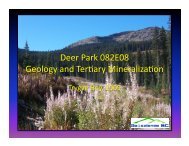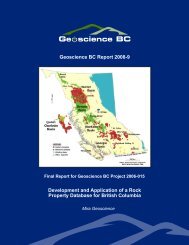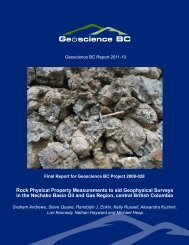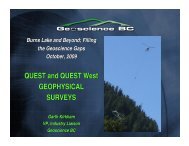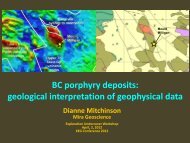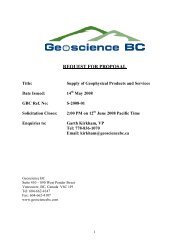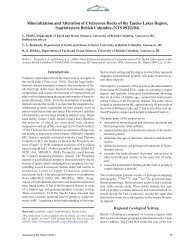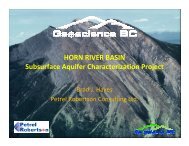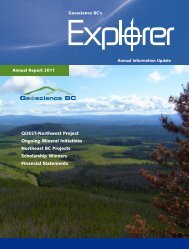Notes Accompanying Original Release of Maps - Geoscience BC
Notes Accompanying Original Release of Maps - Geoscience BC
Notes Accompanying Original Release of Maps - Geoscience BC
- No tags were found...
You also want an ePaper? Increase the reach of your titles
YUMPU automatically turns print PDFs into web optimized ePapers that Google loves.
Metallogenesis <strong>of</strong> the Iskut River Area, Northwestern B.C. --- Regional maps, Lewis<br />
Geological <strong>Maps</strong> <strong>of</strong> the Iskut River Area<br />
by<br />
PETER D. LEWIS<br />
REGIONAL GEOLOGICAL MAPS:<br />
ADDITIONAL NOTES<br />
1:50,000 scale geological maps are included for<br />
map sheets 104 B/8, 104 B/9, and 104 B/10. These<br />
maps are compiled from 1:20,000 scale regional<br />
mapping completed by the MDRU, and from industry<br />
and government mapping <strong>of</strong> areas not visited by the<br />
MDRU. All maps use a single legend included as a<br />
separate sheet.<br />
The stratigraphic divisions used on the maps<br />
differ from those on previous maps <strong>of</strong> the Iskut River<br />
area, particularly within the Hazelton Group. The<br />
Hazelton Group nomenclature used reflects our<br />
improved understanding <strong>of</strong> Hazelton Group<br />
stratigraphy, which has evolved significantly over the<br />
course <strong>of</strong> the Iskut River project through the addition<br />
<strong>of</strong> new mapping constraints, geochronology, and<br />
biochronology. The revised Hazelton Group<br />
nomenclature is outlined below, and will be the subject<br />
<strong>of</strong> a separate upcoming publication.<br />
Revised Hazelton Group Stratigraphy for the<br />
Iskut River area<br />
Geological studies completed in the Iskut River<br />
area over the last decade have provided an extensive<br />
database to draw from in defining new stratigraphic<br />
divisions within the Hazelton Group. Critical new data<br />
sets include: i) 1:20,000 scale mapping <strong>of</strong> about half<br />
<strong>of</strong> the Iskut River map sheet (Alldrick and Britton,<br />
1991,1992; Lewis, 1992, 1993) and 1:50,000 scale<br />
mapping <strong>of</strong> the remainder (Anderson, pers. comm.,<br />
1993); ii) a U-Pb geochronological data base<br />
comprising more than 40 well-constrained stratigraphic<br />
and intrusive ages (Macdonald, this volume, a and b;<br />
Macdonald et al., 1992; Anderson, pers. comm., 1993;<br />
Childe, 1994; Childe et al., 1994; Mortensen, pers.<br />
comm.); iii) structural studies documenting the extent<br />
and geometry <strong>of</strong> structural disruption <strong>of</strong> map units<br />
(Lewis, 1992, 1993); and iv) a biostratigraphic<br />
database <strong>of</strong> over 80 paleontological age determinations<br />
(Nadaraju, 1993).<br />
These studies define three major stratigraphic<br />
divisions within the Hazelton Group. They comprise,<br />
from lowest to highest, i) basal, coarse to fine grained,<br />
locally fossiliferous siliciclastic rocks, ii) porphyritic<br />
andesitic composition flows, breccias, and related<br />
epiclastic rocks; dacitic to rhyolitic flows and tuffs;<br />
and locally fossiliferous marine sandstone, mudstone,<br />
and conglomerate, and iii) bimodal subaerial to<br />
submarine volcanic rocks and intercalated mudstone.<br />
These three rock-stratigraphic units are the smallest<br />
units which fulfill the requirements <strong>of</strong> formation units<br />
as outlined in the Code <strong>of</strong> Stratigraphic Nomenclature,<br />
and we apply the designations Jack Formation, Betty<br />
Creek Formation, and Salmon River Formation to<br />
them.<br />
Jack Formation: Lower Hazelton Group<br />
sedimentary strata:<br />
Basal Hazelton Group typically consists <strong>of</strong><br />
locally fossiliferous conglomerate, sandstone, and<br />
siltstone <strong>of</strong> the Jack Formation. These rocks are well<br />
exposed in the upper Unuk River/Sulphurets area<br />
along both limbs <strong>of</strong> the McTagg Anticlinorium and<br />
have been traced at least as far south as the Frank<br />
Mackie icefield. Strata <strong>of</strong> correlative age are also<br />
present in the Salmon Glacier area. No exposures <strong>of</strong><br />
the Jack Formation are known west <strong>of</strong> Harrymel<br />
Creek. The most complete and best exposed sections<br />
are located in alpine areas north and south <strong>of</strong> John<br />
Peaks and along the west side <strong>of</strong> the Jack Glacier.<br />
The Jack Formation was first defined (informally) by<br />
Henderson et al. (1992), who used the name for<br />
distinctive coarse clastic and calcareous fossiliferous<br />
rocks occurring at the Stuhini Group/Hazelton Group<br />
77
Metallogenesis <strong>of</strong> the Iskut River Area, Northwestern B.C. --- Regional maps, Lewis<br />
contact. Henderson et al. (1992) placed the unit<br />
between the two groups; the present inclusion within<br />
the Hazelton Group is based on the conformable<br />
relationship with overlying rocks and the <strong>of</strong>ten<br />
unconformably contact with Stuhini Group strata.<br />
Lithology:<br />
The Jack Formation is a lithologically varied<br />
sequence <strong>of</strong> sedimentary rocks which overlies Stuhini<br />
Group strata. Best reference sections <strong>of</strong> the Jack<br />
Formation occur at the Bruce Glacier/Jack Glacier<br />
area, south <strong>of</strong> John Peaks, and near Eskay Creek. At<br />
Bruce and Jack glaciers, the formation consists <strong>of</strong> a<br />
thin conglomerate containing clasts <strong>of</strong> subjacent Stuhini<br />
Group turbiditic mudstones and siltstone (Henderson<br />
et al., 1992). Trough cross stratification and<br />
channelized sandstone and conglomerate layers are<br />
common. In one location, a 2-3 m thick welded,<br />
intermediate composition pyroclastic flow deposit is<br />
interstratified with these clastic rocks. Overlying the<br />
basal sequence are fossiliferous limy sandstone and<br />
siltstone, and thinly to medium bedded, locally phyllitic,<br />
turbiditic siltstones and interbedded sandstones, up to<br />
several hundred metres thick. There is a general<br />
transition southward towards John Peaks towards a<br />
thicker basal conglomerate and sandstone, and a<br />
thinner calcareous and turbiditic component. At the<br />
reference section south <strong>of</strong> John Peaks and on the ridge<br />
extending east from Unuk Finger, the Jack Formation<br />
consists entirely <strong>of</strong> conglomerate and sandstone. Well<br />
rounded granitoid cobbles are diagnostic, typically<br />
comprising up to 50% <strong>of</strong> the clasts. West <strong>of</strong> the Unuk<br />
River in the Eskay Creek area, Jack Formation rocks<br />
comprise several hundred metres <strong>of</strong> thickly bedded<br />
to massive wackes with local conglomeratic lenses<br />
and cross-stratified intervals.<br />
At Brucejack Lake, thick sequences <strong>of</strong><br />
sandstones to cobble conglomerates have been<br />
assigned to the Jack Formation, although age data are<br />
lacking and contacts are ambiguous. In the southern<br />
Iskut River area near the Salmon Glacier, Alldrick (<br />
1991) describes thick siltstone intervals which may<br />
be finer-grained equivalents to Jack Formation to the<br />
north. These siltstones, classified as part <strong>of</strong> the Unuk<br />
River Formation by Alldrick, contain faunal<br />
assemblages <strong>of</strong> similar age to assemblages collected<br />
near Eskay Creek from the Jack Formation<br />
(Anderson, 1993).<br />
Contact relationships:<br />
The basal contact <strong>of</strong> the Jack Formation is well<br />
exposed at the Jack Glacier and south <strong>of</strong> John Peaks<br />
as a sharp, angular unconformity. Along strike from<br />
these localities, the contact is less distinct and bedding<br />
is concordant with underlying rocks. However, the<br />
unit can usually be recognized on the basis <strong>of</strong> the<br />
cobble conglomerate beds at its base. In the Treaty<br />
Glacier area to the east, the contact occurs at a<br />
concordant transition from Stuhini Group volcanic<br />
conglomerates to Jack Formation interstratified coarse<br />
sandstone and conglomerate.<br />
No rocks correlative to the Jack Formation have<br />
been identified in the Johnny Mountain area, although<br />
the Stuhini Group/Hazelton Group contact is clearly<br />
defined as a sharp angular unconformity. In this area,<br />
lowest Hazelton Group rocks consist <strong>of</strong> volcanic and<br />
epiclastic strata correlated with the Betty Creek<br />
Formation.<br />
Age:<br />
Fossil assemblages collected from the Jack<br />
Formation in the Unuk River indicate a Lower Jurassic<br />
age. Well-preserved ammonites Paracalocerous and<br />
Badouxia Canadensis occur in the Eskay Creek<br />
reference section and also near Treaty Glacier, and<br />
are diagnostic <strong>of</strong> an Upper Hettangian to Lower<br />
Sinemurian age. Unconformably underlying Stuhini<br />
Group turbiditic siltstone to mudstone in this area<br />
contain Upper Norian Monotis cf subcicularis<br />
bivalves, providing a maximum age constraint. Upper<br />
biostratigraphic age limits are provided by Upper<br />
Pliensbachian ammonite collections from the Betty<br />
Creek Formation near Eskay Creek and near John<br />
Peaks.<br />
Isotopic age constraints from bounding units<br />
corroborate an Early Jurassic age. Dacitic crystal tuff<br />
in the underlying Stuhini Group at John Peaks yields a<br />
U-Pb zircon date <strong>of</strong> 215-220 Ma (V. McNicoll<br />
reported in Anderson, 1993), and a granitoid clast from<br />
the Jack Formation in this same section is dated at<br />
about 225 Ma. U-Pb zircon dates from the overlying<br />
Betty Creek Formation are as old as 193 ± 1 Ma (M.L.<br />
Bevier, pers. comm., 1994).<br />
Betty Creek Formation<br />
Lower Jurassic volcanic and volcaniclastic strata<br />
have been problematic for workers in the Iskut River<br />
area, and stratigraphic nomenclature has been<br />
unevenly applied (see Lewis et al., this volume). Most<br />
studies in the area assign intermediate composition<br />
rocks in this interval to either the Betty Creek<br />
Formation or the Unuk River Formation as defined<br />
78
Metallogenesis <strong>of</strong> the Iskut River Area, Northwestern B.C. --- Regional maps, Lewis<br />
by Grove (1986), and felsic rocks to the Mount<br />
Dilworth Formation. Much <strong>of</strong> the difficulty in working<br />
with this part <strong>of</strong> the section stems from the poor<br />
stratigraphic continuity <strong>of</strong> lith<strong>of</strong>acies, and the lack <strong>of</strong><br />
regional definitions <strong>of</strong> the formations. For example,<br />
the age <strong>of</strong> the Mount Dilworth Formation in its type<br />
area is largely unconstrained, and the type “area” for<br />
the Unuk River Formation is now known to contain a<br />
wide variety <strong>of</strong> rock types representing several<br />
formations.<br />
We assign the entire volcanic and volcaniclastic<br />
sequence from the Jack Formation to a distinct shift<br />
in style <strong>of</strong> volcanism in the lower Middle Jurassic to<br />
the Betty Creek Formation. This formation<br />
encompasses most <strong>of</strong> the rocks previously assigned<br />
to the Betty Creek and Unuk River formations, as<br />
well as some rocks previously assigned to the Mount<br />
Dilworth formation. Use <strong>of</strong> the Unuk River Formation<br />
is discontinued due to its poorly constrained definition.<br />
Within the Betty Creek Formation, three members are<br />
defined. The Unuk River Member comprises andesitic<br />
composition volcanic and volcaniclastic strata, similar<br />
to the rock types included within the original definition<br />
<strong>of</strong> the Unuk River Formation by Grove (1986). The<br />
Brucejack Lake Member <strong>of</strong> the Betty Creek<br />
Formation consists <strong>of</strong> andesitic to dacitic pyroclastic,<br />
epiclastic, and flow rocks which stratigraphically<br />
succeed and may be in part laterally equivalent to parts<br />
<strong>of</strong> the Unuk River Member. The Unuk River and<br />
Brucejack Lake Members are overlain by marine<br />
sedimentary rocks <strong>of</strong> the Treaty Ridge Member.<br />
Unuk River Member: Andesitic flows.<br />
breccias, and volcaniclastic rocks<br />
Andesitic composition flows, volcanic breccias,<br />
and related epiclastic rocks overlying the Jack<br />
Formation are included within the Unuk River Member<br />
<strong>of</strong> the Betty Creek Formation. The Unuk River<br />
Member is well exposed throughout the eastern Iskut<br />
River area, with thickest, best exposed sections at<br />
Eskay Creek, Johnny Mountain, Treaty Creek, and<br />
Salmon Glacier. The thickness <strong>of</strong> the Unuk River<br />
Member varies substantially: coarse volcanic breccias<br />
locally form accumulations up to 2 km thick; these<br />
localized deposits may pinch out completely in<br />
distances <strong>of</strong> less than 5 km.<br />
Lithology:<br />
The thickest and best preserved sections <strong>of</strong> the<br />
Unuk River Member are near Treaty Creek and in<br />
the Sulphurets area. In these locations, hornblende +<br />
plagioclase-phyric andesitic to dacitic flows and dark<br />
green volcanic breccias are intercalated with lapilli to<br />
block tuff, and lesser amounts <strong>of</strong> epiclastic sandstone<br />
and wacke. Volcanic breccias are monolithologic to<br />
slightly polylithic, commonly contain vesicular clasts,<br />
and have a plagioclase-rich volcanic matrix. At Salmon<br />
Glacier, two distinct members are differentiable: a<br />
lower porphyritic andesitic volcanic breccia to block<br />
tuff (Unuk River formation <strong>of</strong> Alldrick, 1991),<br />
separated by plagioclase-hornblende-potassium<br />
feldspar megacrystic flows or sills from an upper,<br />
maroon, well bedded epiclastic conglomerate to<br />
sandstone member (Betty Creek Formation <strong>of</strong><br />
Alldrick, 1991).<br />
Contact Relationships:<br />
The Unuk River Member conformably overlies<br />
the Jack Formation in sections exposed at Eskay<br />
Creek, John Peaks, Salmon Glacier, and Treaty Glacier.<br />
At Johnny Mountain, the Unuk River Member forms<br />
the lowermost unit <strong>of</strong> the Hazelton Group and<br />
unconformably overlies the Triassic Stuhini Group. The<br />
upper contact is defined as a transition to either<br />
epiclastic dacitic rocks <strong>of</strong> the Brucejack Lake<br />
Member, or to marine sedimentary rocks <strong>of</strong> the Treaty<br />
Ridge Member.<br />
Age:<br />
The age <strong>of</strong> the Unuk River Member is<br />
constrained by fossils collected from bounding units,<br />
and by isotopic dating <strong>of</strong> volcanic flows at Johnny<br />
Mountain. An older limit <strong>of</strong> Upper Hettangian to<br />
Lower Sinemurian is provided by fossil collections<br />
from the underlying Jack Formation (described above).<br />
Treaty Ridge Member strata overlying the Unuk River<br />
Member at Eskay Creek and near John Peaks contain<br />
Upper Pliensbachian ammonites, bracketing the age<br />
<strong>of</strong> the former to Sinemurian or Pliensbachian.<br />
U-Pb zircon dates at Johnny Mountain<br />
corroborate this timing: Plagioclase-phyric dykes<br />
cutting dacite to andesite Unuk River Member flows<br />
have a U-Pb zircon age <strong>of</strong> 192 ± 3 Ma, while samples<br />
from the unit itself yield U-Pb zircon ages <strong>of</strong> 193 ±<br />
Ma. Overlying felsic tuffs, correlated with the<br />
Brucejack Lake Member, provide a further bracketing<br />
constraint <strong>of</strong> 194 ± 3 Ma (M.L. Bevier, pers. comm.,<br />
1994).<br />
Brucejack Lake Member: Felsic pyroclastic<br />
rocks and rhyolite flows<br />
Dacitic to rhyolitic pyroclastic rocks, epiclastic<br />
79
Metallogenesis <strong>of</strong> the Iskut River Area, Northwestern B.C. --- Regional maps, Lewis<br />
rocks, and volcanic flows within the Betty Creek<br />
Formation are assigned to the Brucejack Lake<br />
Member. These rocks are well exposed in reference<br />
sections at Brucejack Lake, south <strong>of</strong> John Peaks, and<br />
Johnny Mountain. Dacites in the Granduc Mountain<br />
area are also included within the Brucejack Lake<br />
Member. Rocks previously mapped as Betty Creek<br />
Formation in its type area near the Salmon Glacier<br />
are included within the Brucejack Lake Member. The<br />
Brucejack Lake Member is not recognized in the north<br />
central part <strong>of</strong> the map area at Eskay Creek or<br />
between Snippaker and Harrymel Creeks.<br />
Near Granduc Mountain, the Brucejack Lake<br />
member comprises a megaclastic breccia and laterally<br />
equivalent lapilli tuff which overlies bedded crystal to<br />
dust tuff and volcanic conglomerate. To the north,<br />
water-lain crystal and ash tuffs just south <strong>of</strong> John<br />
Peaks, and multiple thin cooling units <strong>of</strong> crystal-rich<br />
welded lapilli tuff at Treaty Creek are likely<br />
equivalents. Possible vent areas for the tuffs at<br />
Brucejack Jake comprise massive, flow banded dacite<br />
domes which grade outward into autobreccia and<br />
massive, hematitic mud matrix volcanic breccia, and<br />
potassium-feldspar megacrystic flow-banded flows.<br />
In the western Iskut River area at Johnny Mountain,<br />
dacitic to rhyolitic flows and welded lapilli tuff which<br />
overlie the lower Hazelton andesite-dacite sequence<br />
form the Brucejack Lake Member.<br />
Age:<br />
Numerous new U-Pb dates indicate that the<br />
early pulse <strong>of</strong> felsic volcanism in the Hazelton Group<br />
near Iskut River spanned a 5-10 million year period.<br />
The oldest age <strong>of</strong> 194 ± 3 Ma was obtained from<br />
flow rocks interlayered with lapilli tuff at Johnny<br />
Mountain (M.L. Bevier, pers. comm., 1994). This<br />
section also represents some <strong>of</strong> the most felsic rocks<br />
included in the Brucejack Lake Member. Zircon<br />
extracted from bedded ash tuffs at John Peaks yielded<br />
a slightly younger U-Pb age <strong>of</strong> 190 ± 1 Ma (R.<br />
Anderson, pers. comm., 1994). Several other isotopic<br />
ages fall within the 185-188 Ma range: Vent-related<br />
dacite at Brucejack Lake yields U-Pb dates <strong>of</strong> 185.6<br />
± 1.0 Ma and 185.8 ± 1 Ma. Laterally equivalent<br />
potassium feldspar megacrystic dacite flows yield<br />
overlapping ages <strong>of</strong> 187.7 +5.8 / -1.5 Ma. In the<br />
Granduc Mountain area, the dacite breccia is nearly<br />
identical in age to Brucejack samples at 186.6 ± 5.6<br />
Ma.<br />
Treaty Ridge Member: Upper sedimentary<br />
sequence<br />
Heterogeneous sedimentary strata including<br />
sandstone, conglomerate, turbiditic siltstone, and<br />
limestone characterize the Treaty Ridge Member <strong>of</strong><br />
the Betty Creek Formation. Many <strong>of</strong> the rock types<br />
<strong>of</strong> the Jack Formation are present in the Treaty Ridge<br />
Member, but the occurrence <strong>of</strong> clasts derived from<br />
Unuk River member volcanic rocks, and the absence<br />
<strong>of</strong> the distinctive granitoid clast conglomerate serve<br />
to differentiate the two units. In areas lacking strata<br />
<strong>of</strong> the Unuk River and Brucejack Lake Members,<br />
such as near the Bruce Glacier, the base <strong>of</strong> the Treaty<br />
Ridge member is difficult to establish.<br />
The Treaty Ridge Member varies from a few<br />
metres to several hundreds <strong>of</strong> metres thick. Thickest<br />
measured sections are present at Treaty Creek and<br />
Eskay Creek, while at Johnny Mountain the unit is<br />
non-existent. The most distinctive rock type within<br />
the unit consists <strong>of</strong> rusty brown to tan weathering,<br />
bioclastic sandstone and intercalated siltstone or<br />
argillite. At Salmon Glacier, this rock type forms a<br />
layer 2-3 m thick, and represents the total thickness<br />
<strong>of</strong> the Treaty Ridge Member. To the north at Treaty<br />
Ridge, the bioclastic unit is succeeded by a several<br />
hundred metre thick turbiditic mudstone to sandstone<br />
section. Bioclastic sandstones are also present in the<br />
Member at Eskay Creek and John Peaks, where they<br />
are interstratified with siltstone, arenitic sandstone,<br />
and heterolithic rounded cobble conglomerate. West<br />
<strong>of</strong> these areas, a thick, grey weathering, mediumbedded<br />
limestone and siltstone sequence is a probable<br />
stratigraphic equivalent.<br />
Age:<br />
Abundant and diverse fauna within the Treaty<br />
Ridge Member which span Upper Pliensbachian to<br />
Upper Aalenian stages (Nadaraju, 1993) suggest that<br />
the unit records a long period <strong>of</strong> volcanic quiescence.<br />
Upper Pliensbachian ammonite collections provide age<br />
constraints at three locations: at Eskay Creek,<br />
bioclastic sandstones contain ammonites Tiltonicerous<br />
cf. propinquum and Protogrammoceras. A<br />
lithologically similar section at John Peaks and<br />
interstatified limestone and siltstone sections to the<br />
west at Lyons Creek both yield the Kunae Zone<br />
(Upper Pliensbachian) ammonite Arieticeras cf<br />
algovianum. At Treaty Creek the base <strong>of</strong> the member<br />
is slightly younger: here diverse faunal collections from<br />
the bioclastic sandstone includes Toarcian belemnites<br />
(G. Jakobs, J. Palfy, pers. comm.). Higher in this same<br />
section, ammonites Tmetoceras cf. Kirki, Leioceras,<br />
80
Metallogenesis <strong>of</strong> the Iskut River Area, Northwestern B.C. --- Regional maps, Lewis<br />
and Pseudoliocerous constrain an Upper Aalenian<br />
age for turbiditic mudstone and siltstone. Together,<br />
these fossil occurrences suggest that sedimentation<br />
spans the Upper Pliensbachian, the Toarcian, and most<br />
<strong>of</strong> the Aalenian stages, although no single section<br />
includes fauna diagnostic <strong>of</strong> all three stages. Isotopic<br />
ages in the Iskut River area are consistent with a<br />
magmatic gap in this time period.<br />
Salmon River Formation: Bimodal volcanic<br />
unit<br />
The upper part <strong>of</strong> the Hazelton Group in the Iskut<br />
River area comprises dacitic to rhyolitic flows and<br />
tuffs, localized interlayered basaltic flows, and<br />
intercalated volcaniclastic intervals. Although these<br />
different rock types can easily be mapped separately<br />
on a property scale, their interfingering nature and<br />
lack <strong>of</strong> continuity dictate that they be grouped into a<br />
single unit for regional mapping purposes. This part<br />
<strong>of</strong> the Hazelton Group has attracted the most attention<br />
<strong>of</strong> geologists due to its association with mineralization<br />
at Eskay Creek, but at the same time its distribution,<br />
internal stratigraphy, and age are poorly understood.<br />
Previous workers have mapped felsic volcanic<br />
components as the Mount Dilworth formation, and<br />
mafic volcanic components as a distinct facies <strong>of</strong> the<br />
Salmon River Formation. These assignments become<br />
problematic with latest mapping constraints which<br />
demonstrate that locally more than one felsic horizon<br />
exists, and that mafic volcanic rocks occur both above<br />
and below these felsic intervals.<br />
The accompanying maps assign all Hazelton<br />
Group rocks above the Treaty Ridge Member to the<br />
Salmon River Formation, which is subdivided into the<br />
Bruce Glacier, Troy Ridge, Eskay Rhyolite, and John<br />
Peaks members.<br />
Bruce Glacier Member:<br />
The Bruce Glacier Member <strong>of</strong> the Salmon River<br />
Formation comprises widely distributed dacite to<br />
rhyolite flows, tuffs, and epiclastic rocks. These rocks<br />
vary from as little as a few tens <strong>of</strong> metres to over<br />
400 metres in thickness, with thickest accumulations<br />
on the west limb <strong>of</strong> the McTagg Anticlinorium<br />
between the Bruce Glacier and the Iskut River valley.<br />
Lith<strong>of</strong>acies within the member are highly variable both<br />
regionally and vertically in a given section. Deposits<br />
proximal to extrusive centres include banded flows,<br />
massive domes with carapace breccias, autoclastic<br />
megabreccias, and block tuffs. Extrusive centres have<br />
been identified at several locations in the Iskut River<br />
area, including Brucejack Lake, Julian Lake (near the<br />
headwaters <strong>of</strong> Snippaker Creek) and Bruce Glacier.<br />
These felsic extrusive centres are characterized by<br />
thick, domal porphyritic centres, grading outward to<br />
flow breccias and talus piles. Slightly to densely<br />
welded lapilli to ash tuffs characterize more distal<br />
equivalents. Reworked tuffs locally form thick<br />
epiclastic accumulations and may fill in paleobasins<br />
adjacent to extrusive centres.<br />
Troy Ridge Member:<br />
Sedimentary and tuffaceous sedimentary rocks<br />
<strong>of</strong> the Salmon River Formation are assigned to the<br />
Troy Ridge Member. This member includes the<br />
distinctive black and white striped strata known as<br />
the “pyjama beds” at Salmon River and are present<br />
to a lesser extent in northern parts <strong>of</strong> the area and<br />
the mineralized contact zone mudstone at Eskay<br />
Creek. Contact relations with other Salmon River<br />
Formation members are variable: for example, at<br />
Eskay Creek the member lies above the Eskay<br />
Rhyolite and Bruce Glacier Members, but below the<br />
John Peaks Member. At Julian Lakes the member is<br />
interstratified with rocks assigned to both the John<br />
Peaks and Bruce Glacier members. These types <strong>of</strong><br />
stratigraphic relationships suggests that the Troy Ridge<br />
Member represents sediments accumulated during<br />
breaks in local volcanic activity.<br />
John Peaks Member:<br />
Mafic components <strong>of</strong> the Salmon River<br />
Formation, assigned here to the John Peaks Member,<br />
are localized in their distribution and are missing from<br />
much <strong>of</strong> the Iskut River area. Generally they occur<br />
above the felsic members (Bruce Glacier and Eskay<br />
Rhyolite), but at Treaty Creek thick sections <strong>of</strong> mafic<br />
flows and breccias lie below welded tuffs <strong>of</strong> the Bruce<br />
Glacier Member. Mafic sections are thickest at Mount<br />
Shirley and near the mouth <strong>of</strong> Sulphurets Creek, and<br />
form intermediate thicknesses at Eskay Creek and<br />
Johnny Mountain. Textures present include massive<br />
flows, pillowed flows, broken pillow breccias, and<br />
volcanic breccias. Plagioclase phenocrysts up to 2 cm<br />
long are characteristic <strong>of</strong> the pillowed sequence south<br />
<strong>of</strong> John Peaks. At Treaty Glacier the mafic<br />
component grades upward from pillowed and massive<br />
flows into broken pillow breccia, and finally,<br />
hyaloclastite matrix supporting abundant irregular<br />
globular volcanic fragments.<br />
Eskay Rhyolite Member:<br />
81
Metallogenesis <strong>of</strong> the Iskut River Area, Northwestern B.C. --- Regional maps, Lewis<br />
Rhyolite flows, breccias, and tuffs in the Eskay<br />
Creek area are assigned to the Eskay Rhyolite<br />
Member <strong>of</strong> the Salmon River Formation. Although<br />
this rhyolite is lithologically similar to some exposures<br />
<strong>of</strong> the Bruce Glacier Member, particularly in the<br />
Virginia Lake region, it can be distinguished<br />
geochemically on the basis <strong>of</strong> an Al:Ti ratio <strong>of</strong> greater<br />
than 100. At Eskay Creek, the member forms a<br />
distinct mappable unit overlying the Bruce Glacier<br />
Member and underlying the John Peaks Member, with<br />
thicknesses <strong>of</strong> up to 250 m.<br />
Age:<br />
Age constraints for the Salmon River Formation<br />
include U-Pb zircon ages from the Bruce Glacier<br />
Member and fossil collections from intercalated<br />
sedimentary sections assigned to the Troy Ridge<br />
Member. Because <strong>of</strong> the interfingering relationships<br />
<strong>of</strong> the different members these determinations are<br />
interpreted as being representative <strong>of</strong> the entire<br />
formation.<br />
U-Pb zircon dates obtained from the Bruce<br />
Glacier Member bracket the age <strong>of</strong> the unit to around<br />
172-178 Ma. At Bruce Glacier, a U-Pb age <strong>of</strong> 176.2<br />
± 2.2 Ma has been obtained from flow-banded dacites<br />
near the base <strong>of</strong> the section. Stratigraphically<br />
equivalent flows across the Unuk River valley have<br />
yielded a U- Pb age <strong>of</strong> 173.6 Ma + 5.6/-0.5 Ma<br />
(Childe, 1994). In the Snippaker Creek area, two U-<br />
Pb ages fall within this same range: 172.3 ± 1.0 Ma,<br />
and 178.2 ± 5.0 Ma.<br />
Fossil collections from within the Troy Ridge<br />
Member are consistent with U-Pb age determinations<br />
<strong>of</strong> adjacent rocks, but are problematic when compared<br />
to biochronological constraints from the underlying<br />
Betty Creek Formation. Fossil collections at Eskay<br />
Creek indicate a middle Bajocian age for the unit,<br />
while slightly older Upper Toarcian ammonites have<br />
been collected from the Julian Lakes area. This<br />
Toarcian age is older than Upper Aalenian ammonites<br />
from the Treaty Ridge Member at Treaty Ridge,<br />
indicating that either formations are diachronous<br />
across the map area, or that units at Julian Lakes<br />
should be reassigned to lower positions.<br />
Mount Dilworth Formation:<br />
The term “Mount Dilworth Formation”, as<br />
defined by Alldrick (1991) has been applied to felsic<br />
volcanic portions <strong>of</strong> the Hazelton Group throughout<br />
the Iskut River area. Recognition that the Hazelton<br />
Group contains multiple, temporally distinct felsic<br />
volcanic intervals casts many <strong>of</strong> these assignments in<br />
doubt. One objective <strong>of</strong> the MDRU research program<br />
has been to obtain conclusive age data for both the<br />
type Mount Dilworth Formation and for mappable<br />
felsic intervals to the north, and if possible, to establish<br />
map continuity between the type section and more<br />
northerly areas. Despite several attempts, no wellconstrained<br />
age has been determined for the<br />
formation’s type area, and map continuity is lacking.<br />
In order to avoid possible erroneous correlations, the<br />
term “Mount Dilworth Formation” has been dropped<br />
from the MDRU maps, and the stratigraphic<br />
nomenclature used is based on type sections within<br />
the area mapped as part <strong>of</strong> the study. Felsic intervals<br />
which might have previously been included in the<br />
Mount Dilworth Formation are now assigned to either<br />
the Brucejack Lake Member <strong>of</strong> the Betty Creek<br />
Formation, or the Eskay Rhyolite or Bruce Glacier<br />
Member <strong>of</strong> the Salmon River Formation, depending<br />
on age and stratigraphic position.<br />
REFERENCES<br />
Alldrick, D.J., 1991, Geology and ore deposits <strong>of</strong> the<br />
Stewart mining camp, British Columbia:<br />
Unpublished Ph.D. thesis, Vancouver, B.C.,<br />
University <strong>of</strong> British Columbia, 347 p.<br />
Alldrick, D.J. and Britton, J.M., 1991, Sulphurets area<br />
geology: British Columbia Ministry <strong>of</strong> Energy,<br />
Mines and Petroleum Resources Open File Map<br />
1991-21.<br />
---------- 1992, Unuk area geology: British Columbia<br />
Ministry <strong>of</strong> Energy, Mines and Petroleum<br />
Resources Open File Map 1992-22.<br />
Anderson, R.G., 1993, A Mesozoic stratigraphic and<br />
plutonic framework for northwestern Stikinia (Iskut<br />
River area), northwestern British Columbia, in<br />
Dunne, G. and McDougall, K., eds., Mesozoic<br />
paleogeography <strong>of</strong> the western United States, II:<br />
Los Angeles, CA, Society <strong>of</strong> Economic<br />
Paleontologists and Mineralogists, Pacific Section,<br />
p. 477-494.<br />
Childe, F.C., 1994, Radiogenic isotopic investigations <strong>of</strong><br />
the Eskay Creek volcanic hosted massive sulphide<br />
deposit, British Columbia, Canada [abs.]: United<br />
States Geological Survey Circular 1107, p. 58.<br />
Childe, F.C., Barrett, T.J. and McGuigan, P.J., 1994, The<br />
Granduc VMS deposit, northwestern British<br />
Columbia: U-Pb ages and Pb isotope relations<br />
[abs.]: Geological Society <strong>of</strong> America Abstracts<br />
with Programs, v. 26; 7, p. 381.<br />
82
Metallogenesis <strong>of</strong> the Iskut River Area, Northwestern B.C. --- Regional maps, Lewis<br />
Grove, E.W., 1986, Geology and mineral deposits <strong>of</strong> the<br />
Unuk River-Salmon River-Anyox area: British<br />
Columbia Ministry <strong>of</strong> Energy, Mines and Petroleum<br />
Resources Bulletin 63, 152 p.<br />
Henderson, J.R., Kirkham, R.V., Henderson, M.N.,<br />
Payne, J.G., Wright, T.O. and Wright, R.I., 1992,<br />
Stratigraphy and structure <strong>of</strong> the Sulphurets area,<br />
British Columbia, (104 B/8, 9): Canada Geological<br />
Survey Paper 92-1A, p. 323-332.<br />
Lewis, P.D., 1992, Structural geology <strong>of</strong> the Prout Plateau<br />
region, Iskut River map area, British Columbia:<br />
British Columbia Ministry <strong>of</strong> Energy, Mines and<br />
Petroleum Resources Paper 1992-1, p. 521-528.<br />
---------- 1993, Stratigraphic and structural setting <strong>of</strong> the<br />
Iskut River area, in Metallogenesis <strong>of</strong> the Iskut<br />
River area, northwestern British Columbia:<br />
Unpublished Annual Technical Report - Year 3,<br />
Mineral Deposit Research Unit, University <strong>of</strong><br />
British Columbia.<br />
Lewis, P.D., Macdonald, A.J. and Bartsch, R.D., (this<br />
volume), Hazelton Group/Bowser Lake Group<br />
stratigraphy in the Iskut River area: progress and<br />
problems, in Metallogenesis <strong>of</strong> the Iskut River<br />
area, northwestern British Columbia: Mineral<br />
Deposit Research Unit Special Publication<br />
Number 1.<br />
Macdonald, A.J., (this volume, a), Eskay Porphyry, in<br />
Metallogenesis <strong>of</strong> the Iskut River area,<br />
northwestern British Columbia: Mineral Deposit<br />
Research Unit Special Publication Number 1.<br />
---------- (this volume, b), Kerr-Sulphurets camp and<br />
Brucejack Lake, in Metallogenesis <strong>of</strong> the Iskut<br />
River area, northwestern British Columbia:<br />
Mineral Deposit Research Unit Special Publication<br />
Number 1.<br />
Macdonald, A.J., van der Heyden, P., Lefebure, D.V.<br />
and Alldrick, D.J., 1992, Geochronometry <strong>of</strong> the<br />
Iskut River area - an update: British Columbia<br />
Ministry <strong>of</strong> Energy, Mines and Petroleum<br />
Resources Paper 1992-1, p. 495-502.<br />
Nadaraju, G., 1993, Triassic-Jurassic biochronology <strong>of</strong><br />
the eastern Iskut River map area, northwestern<br />
British Columbia: Unpublished M.Sc. thesis,<br />
Vancouver, B.C., University <strong>of</strong> British Columbia,<br />
223 p.<br />
83





